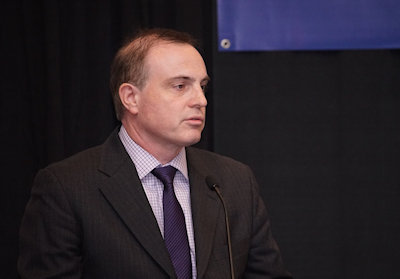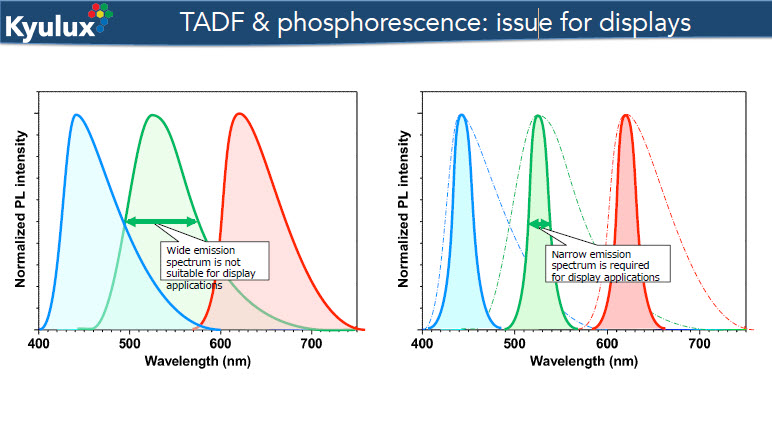 Kyulux was represented at the Investors’ Conference by Christopher Savoie, who is the CEO. The firm was founded in 2015, but based on long-established research and it has 30 researchers. It has a ‘globally-oriented’ management team.
Kyulux was represented at the Investors’ Conference by Christopher Savoie, who is the CEO. The firm was founded in 2015, but based on long-established research and it has 30 researchers. It has a ‘globally-oriented’ management team.
Savoie explained the hyper-fluorescence technique that the company has developed in its TADF materials which are said to be better than the phosphorescent blue materials that companies such as UDC have developed and the TADF material is fully organic. The TADF molecules can produce ‘pretty well any colour’ and there has been published data on 100% EQE in a deep blue. However, TADF materials tend to produce wide bandwidth which needs filtering for the pure colours needed for displays. The Kyulux material gets a much narrower bandwidth that doesn’t need filtering, Savoie claimed.
TADF upconverts triplets to singlets, whereas phosporescent materials convert singlets to triplets. The singlets are emitted in a very consistent way so you get a very bright output. By adding a TADF material to a fluorescent emitter, you can get 25% EQE, up from 5% for the commercial fluorescent material alone. Colour quality can also be made much better by using the TADF material.
 Kyulux pointed out that narrow spectrums are needed for display applications
Kyulux pointed out that narrow spectrums are needed for display applications
The complany has a stable sky blue emitter material and is working on a deep blue, but details will not be released until the company is closer to commercialisation. The OLED market is very fragmented because there are many layers and the materials may come from different companies and that makes it hard to develop full OLED stacks (as we reported on from Electronic Displays in Nuremberg, the LG OLED stack has at least 19 layers, and possibly 22). That limits the speed at solving the issues such as lifetime. Companies bring their own ‘white powders’ to an integrator such as LG or Samsung, but with little information, which means that integrators have to use trial and error to try to optimise the stack. Kyulux has developed an AI approach that allows modelling of the full system that should help with this. Savoie said it’s like building a car – all the components have to work together to make a good car.
Savoie said that the software that it has developed has ‘deep learning’ using AI technology. This has accelerated the development and using the software, the company was able to create a yellow emitter with a long life between January and May this year so that life could get to 47,000 hours.
Looking at lifetimes, Savoie said that red is at 10,000 hours, yellow is at 47,000 and green is at 31,000 hours now, with 1,000 cd/m² and the company is close to commercialisation.
The company has over 200 patents including two blocking patents on the basic hyperfluoresence
Analyst Comment
Savioe did not comment on the recently announced collaboration with Nanoco. (Nanoco and Kyulux to Develop and Market Their Technologies Collaboratively) (BR)

